Review of late varieties of apples
Thanks to modern breeding, a wide variety of late varieties of apples have been bred, which grow in almost every garden plot. Having familiarized yourself with their name and description, you can choose the most suitable plant for your area and get a good and high-quality harvest from it.
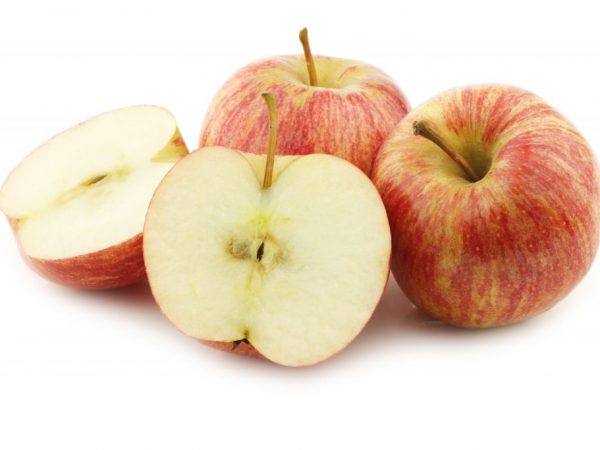
Review of late varieties of apples
Benefits
Late varieties of apple trees have important advantages that are not inferior to summer and autumn varieties:
- have good vitality and survival in any climatic conditions;
- long shelf life of the crop - throughout the year;
- universality of use - winter apples are used to prepare various desserts, pastries and preparations for the winter;
- good indicators of winter hardiness and disease resistance;
- large-fruited;
- late ripening dates - from the last decade of September to the last days of October, depending on the species.
Varieties
Modern selection presents several unique late winter apple varieties with different ripening periods, taste and fruit color.
Aport
One of the oldest hybrids. First appeared on Ukrainian and Polish lands. Later, the culture began to be successfully cultivated in the territory of Almaty.
The apple tree is late, vigorous and highly productive. Produces fragrant and very tasty apples (weight up to 200 g).
Harvesting takes place in the first month of autumn. Fruit is well transported. From them, preparing candied fruits, marshmallows, preserves for the winter and delicious desserts.
This apple tree is weakly resistant to severe winters, therefore it is more suitable for cultivation in the southern zone and in the territory of the Central strip.
Antaeus
Medium-sized culture - the central conductor reaches 2.5-3 m in height. The aboveground part is spherical or pyramidal, with medium branching and foliage.
The branches are not too thick, covered with smooth bark, light brown in color. The leaves are dark green, oval, large.
One of the early maturing winter hybrids that enters the fruiting phase in the second or third year of growing.
Main advantages:
- bears fruit every year, regardless of climatic conditions;
- high yields - up to 50 kg of fruits from one adult tree;
- good frost resistance - tolerates the most severe winters;
- large-fruited (weight up to 200 g);
- harvesting is carried out in the last days of September or in the first decade of October;
- versatility of use - they are consumed fresh and processed into juices, preserves, jams and compotes;
- they are well transported and lie for a long time - they are stored for about six months without losing the original taste and presentation.
The plant has no immunity against fungal sores and is often affected by scab. Suitable for the north-west of Siberia, the Urals, the Central strip and the Moscow region.
Moscow winter
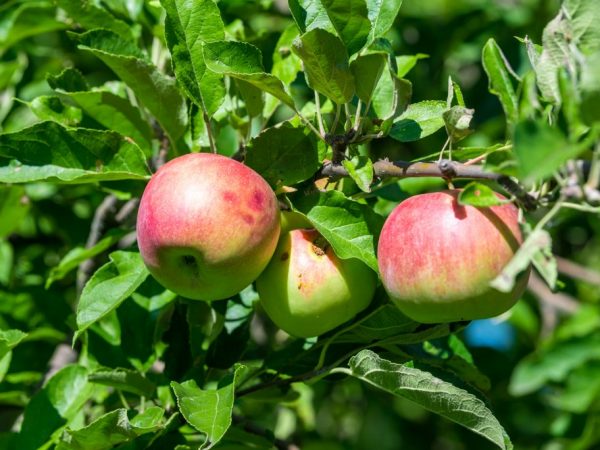
The apple tree will delight you with large fruits
This hybrid was obtained by crossing two varieties of seedlings - Welsey and Antonovka.
The Moscow winter tree has several unique qualities:
- high fertility;
- compactness and average height (does not take up much space in the garden);
- resistance to sores and severe frosts, which allows it to be successfully grown throughout Russia;
- large apples - from 200 to 230 g;
- medium late ripening - September-October;
- the crop has a long shelf life - until mid-spring in cool conditions (cellar, basement or refrigerator).
Moscow winter is a versatile variety and is widely used in cooking.
North synap
Due to its high winter hardiness, this tree can be grown in any zone of the country, even in Siberia. It has good immunity to disease.
- A tree obtained on a dwarf rootstock begins to bear fruit already in the 2nd year of cultivation.
- A seedling grown from a seedling gives its first fruits 3-4 years after planting.
Apples do not differ in large size - they weigh from 110 to 130 g. They ripen in October and lie for a long time, subject to late harvest (after leaf fall). The shelf life is 6-7 months.
Bogatyr
This hybrid was obtained by Ukrainian breeders. 2 varieties were taken as a basis - Antonovka and Ranet Landsberg.
The hero has one of the important qualities - large-fruited (weight varies from 170 to 190 g). When normalizing fruit ovaries, it is possible to get apples up to 400 g.
Despite the fact that the harvest ripens in the second decade of September, it gains consumer maturity in January.
The main characteristics of the apple tree:
- early ripeness - the first fruits ripen in the 4th year of cultivation;
- intensive growth and development - at a mature age the tree reaches 6 m in height, therefore it requires a lot of space on the site;
- high yield rates - at the 5th year of life, the tree gives about 100 kg.
Isetskoe
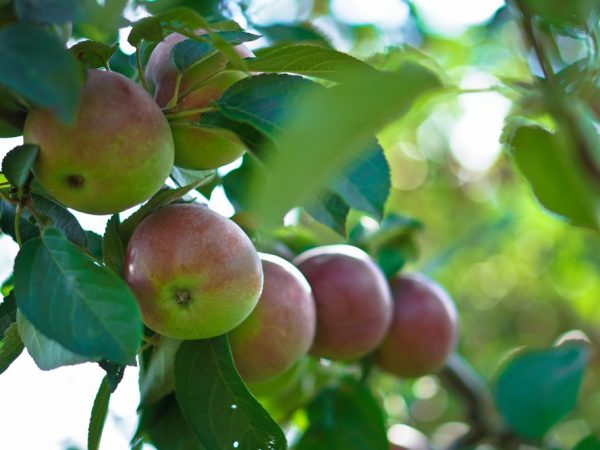
The crop can be kept fresh for about five months.
Ural winter hybrid, the parents of which are two varieties - Yantar and Generous.
Does not differ in early fruiting - the first apples can be removed in the 5th year of cultivation.
Harvested in September-October.
It is appreciated for its long shelf life - about 5 months.
The tree is of medium height (4 m), resistant to winter cold. The apple is green, with a red barrel, weighs no more than 100 g, does not crumble for a long time and has a sweet and sour taste.
Gloucester
The late autumn hybrid, bred by German breeders, has a small crown and increased winter hardiness, therefore, it is successfully grown in the Middle Belt, Moscow Region, the Urals and Siberia.
Gloucester practically does not suffer from fungal and viral sores.
The apples are sweet, with a slight sourness. Burgundy color, weigh about 150 g. Harvesting is carried out in the last decade of September.
In cool and low humidity conditions, they are stored until spring. They have good transportability.
Golden Ragers
This hybrid is a clone of the Golden Delicious variety and is one of the most successful developments of breeders.
A tall tree - reaches 5-6 m in height, does not get sick with powdery mildew and scab.
Apples of yellow color with a pink barrel. One of the most delicious yellow apples with an unusual aftertaste - reminiscent of the aroma of melon or pear. The fruits ripen small - about 80-100 g, but with timely normalization of the ovaries, you can get larger specimens - up to 170-200 g.
Cleaning takes place at the end of September.
- A tree grown on a dwarf rootstock begins to bear fruit already in the second year after vaccination.
- The trees obtained from the seedling are late summer - they begin to bear fruit in the fifth or sixth year and bear fruit for 20 years.
Subject to all the rules of agricultural technology and care, the plants give consistently high yields. This hybrid is very popular not only in private, but also in commercial gardening.
Cameo
One of the most popular red winter hybrids, derived from 2 varieties - Red Delicious and Golden Delicious.
The culture description includes the following characteristics:
- vigorous growth - height 5-6 m;
- high yield - up to 60 kg of fruits from one adult plant;
- large-fruited (from 200 to 230 g);
- possesses excellent taste, long-term keeping quality and transportability.
This apple tree has red, juicy and sweet and sour fruits. Cleaning takes place in the last decade of September. The crop is laid in a cellar or basement for long-term storage - until the beginning or middle of spring.
Pinova
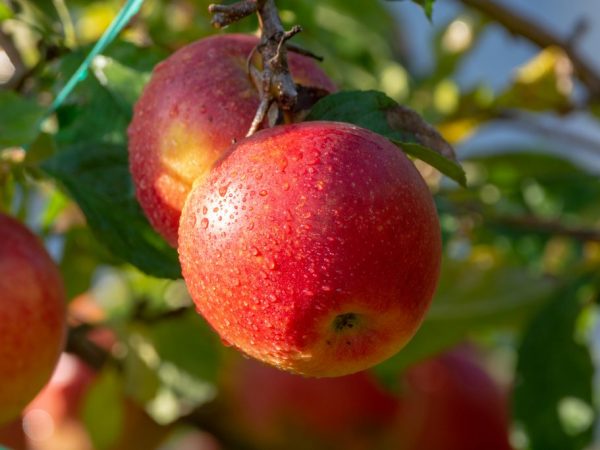
The fruits taste good.
One of the most popular German varieties, which has several important qualities:
- annual and stable fertility;
- the degree of frost resistance is high;
- large-fruited (about 200 g);
- attractive fruits - spherical, very bright, orange-red tone;
- taste - sweet and sour, juicy.
When normalizing the ovaries, you can get larger fruits with a rich color.
Rajka
A variety of Czech selection. It is characterized by strong growth, annual fertility, does not freeze in winter, no more viral and fungal diseases.
Apples weigh about 200 g, burgundy color, juicy, sweet and sour. Maturing term - the first decade of October.
The first fruits ripen in the 2nd year of cultivation. The tree grows annually, regardless of weather and climatic conditions.
The harvest is stored until spring. Suitable for consumption after ripening and further processing.
Breburn
A hybrid of New Zealand selection, which is most suitable for growing in the seaside area.
The fruits are large - from 250 to 350 g, bright yellow, with a reddish blush on the barrel, very juicy, aromatic and sweet.
Ripening dates - the last decade of September. Harvesting is carried out in two stages. The fruits do not crumble for a long time and are stored for six months.
Idared
Winter seedlings of this culture were obtained by crossing two varieties - Jonathan and Wagner.
The plant is medium-sized - about 3-3.5 m. It tolerates severe frosts and drought well. The tree gives its first fruits in the 3-4th year of cultivation.
Idared apples are red, sweet and aromatic, weighing from 150 to 190 g.
Harvesting begins in early October. In a cool room with low humidity, it is stored until March. The fruits tolerate long-term transportation well.
The tree is an excellent pollinator for many other varieties. It is used for making jam, jam, juice and other preparations for the winter.
Jonathan
This late apple was produced by American breeders and has medium vigor and good yields.
Fruits of average weight - 120-150 g, rounded, greenish-yellow in color, with a rich red and striped blush. The pulp is dense, juicy, sour-sweet.
Harvesting begins in mid-September, and stored in cool conditions until May.
Fertility is high, the formation of ovaries begins in the 5th year of cultivation. From one plant, you can remove from 50 to 80 kg of apples.
The tree does not tolerate frost well and freezes heavily, therefore it needs a good shelter for the winter. Resistance to scab is high, to powdery mildew - low.
Venyaminovskoe
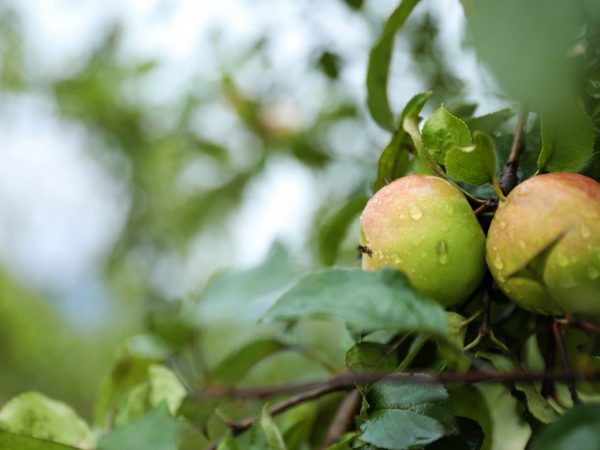
The variety Venyaminovskoye is frost-resistant
A relatively new hybrid of domestic selection, specially designed for cultivation in the regions of the Central strip and the Moscow region.
The tree is winter-hardy, has good immunity to scab and viral infections.
Small apples (120-150 g), green in color, with a reddish blush. They are well stored for 4 months, they are successfully transported over long distances.
Mac
The autumn hybrid Macintosh or Mequintosh was bred by Canadian breeders. In Russia it is better known under the name - Autumn Horoshevka, Autumn Excellent or Autumn Red-sided.
The tree grows up to 3-4 m.Medium sized apple - weight varies from 120 to 150 g. The main color is light green, the surface color is burgundy. Fruits are thin-skinned, smooth with a light waxy coating, contain a light yellow subcutaneous speck.
Fertility: about 30 kg per tree when grown in private gardening. Under industrial growing conditions - up to 400 kg.
Late apples - appear in the 7th year of life.
Perlyna Kiev
The plant of Ukrainian selection is one of the best achievements and has several unique qualities:
- high immunity against scab;
- early fruiting - in the 3rd year of cultivation;
- bears fruit every year, regardless of climatic conditions;
- high marketability and taste (burgundy apples).
- fruit weight 170-200 g;
- harvesting is carried out in mid-September;
- used for cultivation in both private and industrial horticulture.
Syabryna
This plant, obtained by Belarusian breeders, is adapted to the climatic conditions of Belarus, the Middle Belt and the Moscow region.
The tree is up to 4 m in height, which greatly facilitates its care, is characterized by stable and high fertility, early maturity (gives fruits in the 3rd year of cultivation).
The apples are yellow with a pronounced raspberry blush on the side. Average weight - 150 -170 g. Stored until early March. The picking takes place in September.
Imrus
The Antonovka variety was taken as a basis for breeding a new hybrid, therefore the tree has good resistance to severe winters, a long shelf life and excellent transportability.
The plant is compact in size (up to 4 m high), practically not affected by viral and fungal infections, suitable for growing in all regions of our country.
Produces stable and annual yields. The apple is green with a white speck. The picking takes place at the end of September. Stored for 5-6 months in cool conditions.
Secrets of Successful Growing
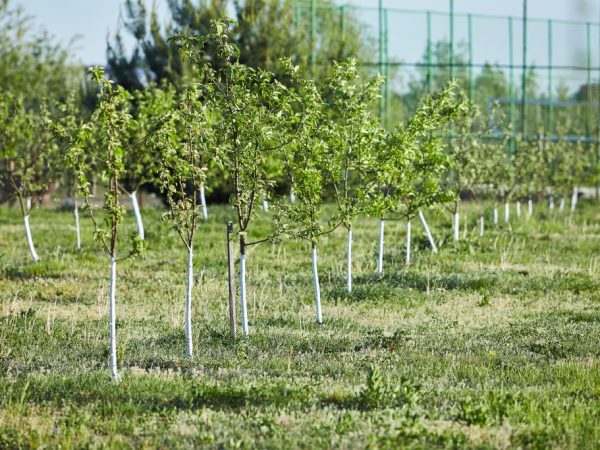
Apple trees need to be well looked after
- For planting, it is better to use healthy one-year or two-year-old seedlings with strong roots and an aerial part.
- When planting, it is important to observe the timing - for the regions of the Middle Lane, spring planting is recommended (at the end of April or at the beginning of May), for the southern zone, autumn planting will be preferable (in early-mid September).
- You need to plant trees on loamy soil, well fertilized with organic and mineral fertilizing, in a sunny place where there is no stagnant water.
- In the process of leaving, seedlings should be often watered, mulched, fertilized with nitrogen and phosphorus-potassium preparations, and also provide good shelter for the winter.
- Regular pruning is essential for proper crown formation and to protect against damage from diseases and parasites.
- For prevention, trees should be treated with copper-containing preparations (copper sulfate or Bordeaux mixture) in spring and autumn to avoid the appearance of diseases and pests.
Gardeners reviews
Thanks to modern breeding, gardeners are presented with a great variety of winter varieties of apple trees, which are grown today throughout Russia. These fruit crops have gained great popularity due to several qualities:
- good winter hardiness;
- high immunity against diseases and pests;
- stable and high yield.
When cultivating winter apple trees, it is important to follow all the rules of agricultural technology and care in order to get a healthy and productive garden.


